A grand jury is a jury—a group of citizens—empowered by law to conduct legal proceedings, investigate potential criminal conduct, and determine whether criminal charges should be brought. A grand jury may subpoena physical evidence or a person to testify. A grand jury is separate from the courts, which do not preside over its functioning.

The counties of Ireland are historic administrative divisions of the island. They began as Norman structures, and as the powers exercised by the Cambro-Norman barons and the Old English nobility waned over time, new offices of political control came to be established at a county level. The number of counties varied depending on the time period, however thirty-two is the traditionally accepted and used number.
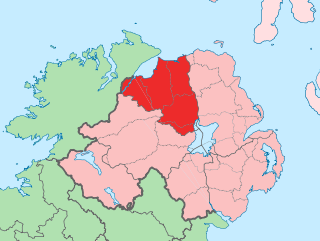
County Londonderry, also known as County Derry, is one of the six counties of Northern Ireland, one of the thirty-two counties of Ireland and one of the nine counties of Ulster. Before the partition of Ireland, it was one of the counties of the Kingdom of Ireland from 1613 onward and then of the United Kingdom after the Acts of Union 1800. Adjoining the north-west shore of Lough Neagh, the county covers an area of 2,118 km2 (818 sq mi) and today has a population of about 252,231.
A riding is an administrative jurisdiction or electoral district, particularly in several current or former Commonwealth countries.

The Local Government (Ireland) Act 1898 was an Act of the Parliament of the United Kingdom of Great Britain and Ireland that established a system of local government in Ireland similar to that already created for England, Wales and Scotland by legislation in 1888 and 1889. The Act effectively ended landlord control of local government in Ireland.

The Light Railways Act 1896 was an act of the Parliament of the United Kingdom of Great Britain and Ireland.
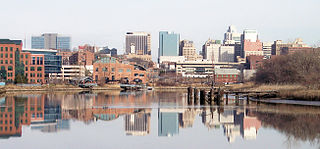
Ultra vires is a Latin phrase used in law to describe an act that requires legal authority but is done without it. Its opposite, an act done under proper authority, is intra vires. Acts that are intra vires may equivalently be termed "valid", and those that are ultra vires termed "invalid".
A county corporate or corporate county was a type of subnational division used for local government in England, Wales, and Ireland.

The London Passenger Transport Board was the organisation responsible for local public transport in London and its environs from 1933 to 1948. In common with all London transport authorities from 1933 to 2000, the public name and brand was London Transport.
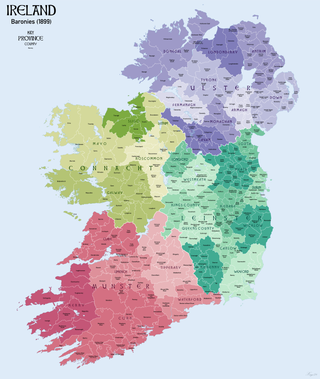
In Ireland, a barony is a historical subdivision of a county, analogous to the hundreds into which the counties of England were divided. Baronies were created during the Tudor reconquest of Ireland, replacing the earlier cantreds formed after the original Norman invasion. Some early baronies were later subdivided into half baronies with the same standing as full baronies.

Northern Ireland is divided into six counties, namely: Antrim, Armagh, Down, Fermanagh, Londonderry and Tyrone. Six largely rural administrative counties based on these were among the eight primary local government areas of Northern Ireland from its 1921 creation until 1973. The other two local government areas were the urban county boroughs of Derry and Belfast.

The Schull and Skibbereen Railway was a minor narrow gauge railway in County Cork, Ireland. It opened in 1886 and closed in 1947. The track gauge was a 3 ft narrow gauge. The formal name of the company was The West Carberry Tramways and Light Railways Company Ltd.

The Cork, Blackrock and Passage Railway (CB&PR) was a 3 ft narrow gauge railway in County Cork, Ireland. The line originally opened in 1850 as a 5 ft 3 in Irish standard gauge railway between Cork and Passage West and operated steam feeder ferries to other locations round Cork Harbour. The company was heavily dependent on summer tourist traffic for a considerable proportion of its revenue. The railway was converted to 3 ft narrow gauge in 1900 in conjunction with extensions southwards to Crosshaven which were completed in 1904. The railway closed in 1932 and has since been replaced by a public pathway and nature area.

The Cork and Muskerry Light Railway was a 3 ft narrow gauge railway in County Cork, Ireland. The first part of the railway opened in 1887 and closed in 1934. A major reason for building the railway was to exploit tourist traffic to Blarney Castle.
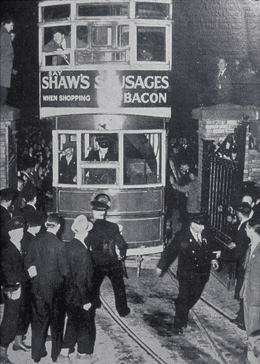
Dublin tramways was a system of trams in Dublin, Ireland, which commenced line-laying in 1871, and began service in 1872, following trials in the mid-1860s. Established by a number of companies, the majority of the system was eventually operated by forms of the Dublin United Tramways Company (DUTC), dominated for many years by William Martin Murphy. Most of the services ran within the city centre and near suburbs, with the majority of major suburbs served. Additionally, there were two longer-range services, one reaching the "excursion" destination of Poulaphouca Falls, and two services concerning Howth.

The Short Titles Act 1896 is an act of the Parliament of the United Kingdom. It replaces the Short Titles Act 1892.
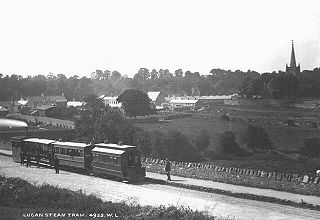
The Dublin and Lucan Steam Tramway operated a 3 ft narrow gauge steam tramway service between Dublin and Lucan between 1880 and 1897. The company was renamed as the Dublin and Lucan Electric Railway Company and steam power was replaced by electricity in 1897. This service ran until 1925.
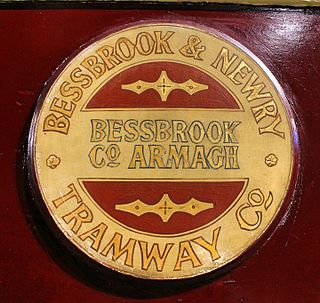
The Bessbrook and Newry Tramway operated a 3 ft narrow gauge, hydro-electrically powered tramway transporting passengers and freight between Bessbrook and Newry in Northern Ireland between 1885 and 1948.
Tramways Act is a stock short titles used in India, New Zealand and the United Kingdom for legislation relating to tramways.














